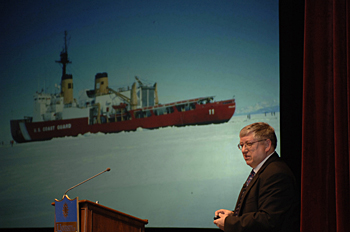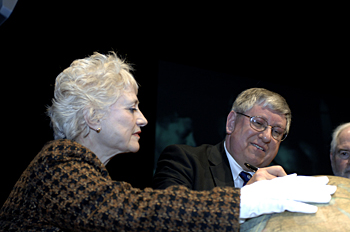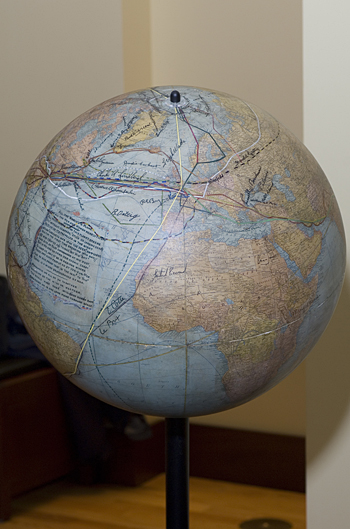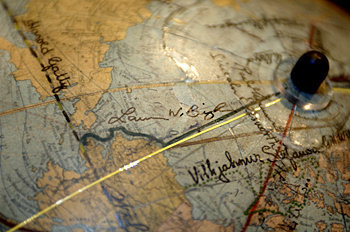
Brigham rewarded his audience with the story, complete with photos, of another group of ice daring souls--he, his crew and a handful of scientists--who spent months aboard the U.S. Coast Guard icebreaker Polar Sea as it barreled its way through the ice of the North Pole. A 5-foot screen on the stage of the Roselle Center for the Arts hung behind Brigham showing pictures of the Polar Sea slicing through ice 5-feet thick, crew members playing football on ice, polar bears that weren't supposed to be that far north and a whale that pushed its head through the ice to communicate with crew members.
Frederick (Fritz) Nelson, professor of geography at UD, opened the globe signing ceremony that was the first event in UD's William S. Carlson International Polar Year celebration.
“In contrast to the situation in 1882 during the first International Polar Year, it has become abundantly clear that what happens in the polar regions ultimately has very strong potential to affect the rest of the world,” Nelson said. This International Polar Year will help underscore the interconnectedness of the polar regions to the rest of the world “on a geographic scale that is truly striking,” he said.
Nelson, whose research focuses on permafrost, periglacial and climatic geomorphology, is also a member of the Intergovernmental Panel on Climate Change, that shared the 2007 Nobel Peace Prize.
He told attendees that the University hopes its participation in International Polar Year will achieve four goals: recognition, appreciation and enthusiasm for the high-latitude regions; a sense of polar community at UD; a distinct role for UD in International Polar Year, and winning recognition for the scope and diversity of UD's polar research.
Jerome E. Dobson, president of the American Geographical Society, the oldest professional geographical organization in the U.S. and keeper of the globe, gave an overview of AGS's influence on geographical research and education since its founding in 1851 and of its impact on polar exploration.

Wilford explained that Finley, as The Times science editor, began inviting heroes of exploration and aviation to sign his globe, and, later, presented it to AGS to continue the tradition.
Noble said newspapers have a long tradition of encouraging daring exploration and that during the early part of the 20th century newspapers competed for readers by obtaining the exclusive rights to explorer's first-person accounts of their expeditions in return for funding.
As part of the Fliers' and Explorers' Globe signing tradition, the last adventurer to sign must pass the pen to the next. In keeping with tradition, Don Walsh, an engineer and ocean scientist who, along with Swiss scientist Jacques Piccard, took a submersible craft deeper beneath the sea than any other human, introduced Brigham and handed him the pen.
“He's a doer as well as a dreamer...a professional sailor who also understands the issues of this vast region,” Walsh said. “I'm very proud to have known him for these years.”
Brigham took the pen as the globe was lifted from its display case and taken to a box lined with a silver cloth. With Walsh at his side, he chose the spot for his name in the Artic region placing his signature amongst the most well-known explorers of the past 126 years. As he signed the globe, the giant screen on the stage allowed attendees to see him penning his name.
Brigham thanked the University for hosting the signing session and for giving him the opportunity to speak about the voyages to the southernmost point a ship can reach in the Antarctica and the Polar Sea's journey through the North Pole, photos highlighted his comments. The Polar Sea sailed the Antarctic in February 1994 and to the North Pole starting that August.
A reception followed the signing.
During an afternoon news conference earlier in the day, Brigham shared his love of the polar regions, his thoughts on global warming and some anecdotes from his scientific operations on board the U.S. Coast Guard's polar icebreaker Polar Sea in the lobby of the Roselle Center for the Arts.The news conference, which was held to welcome Brigham to campus in advance of his historical signing of the American Geographical Society's Fliers' and Explorers' Globe later in the evening, included remarks from Frederick (Fritz) Nelson, professor of geography at UD; Jerome Dobson, director of the American Geographical Society (AGS); Mary Lynne Bird, director of AGS; and Capt. Don Walsh, who signed the globe in 1960 after his bathyscaphe descent with Jacques Piccard to the Marianas Trench, the deepest place in the World Ocean.
Brigham, who commanded the 1994 voyage from the Ross Ice Shelf in Antarctica to the North Pole, said that he was honored to be joining so many history-makers on the globe and added that the invitation to do so came as a complete surprise.
“When we navigated the first voyage to the polar extremes of the Global Ocean, I knew then that it was a special event,” he said, “but here we are 14 years later making it official.”
By adding his name to the globe, Brigham joins more than 75 of the planet's most-celebrated explorers who also are signatories, including Charles Lindbergh, Amelia Earhart, Robert Peary, Roald Amundsen, Richard Byrd, John Glenn and Neil Armstrong.
Brigham said, when asked by a member of the audience where he would sign, that he would be especially honored to make his mark near his home state of Alaska, “somewhere in the middle of the Chukchi Sea.”
After being introduced by Walsh, Brigham shared some memories from his historic circumnavigation, which took him first to Antarctica, where he reached the southernmost location that a ship can reach, before he “crossed the top of the world” to arrive at the North Pole seven months later. “It was a very special operation,” Brigham said, remembering the mixed crew of young Coast Guard recruits and scientists, “and I had the great pleasure of captaining the ship.”
In sharing recollections of his journey, Brigham emphasized that the reason for the operation was scientific, not military, and added that the scope of the research included polar animals as well as the seawater and seacoast.

So far in his career, Brigham has participated in 10 Antarctic expeditions and eight icebreaker voyages in the Arctic Ocean. He served as a researcher at the Woods Hole Oceanographic Institution and the U.S. Naval War College, and as a faculty member at the Coast Guard Academy and Naval Postgraduate School. He earned a doctorate in polar oceanography from the University of Cambridge and a master's degree in management from Rensselaer Polytechnic Institute. Additionally, he is a distinguished graduate of the U.S. Naval War Collage.
The American Geographical Society's Fliers' and Explorers' Globe will remain on display in the University of Delaware's Morris Library through March 14.
Article by Barbara Garrison and Becca Hutchinson
Photos by Kathy Atkinson and Jon Cox


